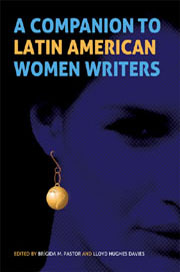Book contents
- Frontmatter
- Contents
- Introduction: The Feminine Voice in Latin American Literature
- 1 Sor Juana Inés de la Cruz (1648/51?–1695)
- 2 Gertrudis Gómez de Avellaneda (1814–1873)
- 3 Gabriela Mistral (1889–1957)
- 4 Alfonsina Storni (1892–1938)
- 5 Silvina Ocampo (1903–1993)
- 6 Clarice Lispector (1920–1977)
- 7 Rosario Castellanos (1925–1974)
- 8 Elena Poniatowska (1933– )
- 9 Alejandra Pizarnik (1936–1972)
- 10 Luisa Valenzuela (1938– )
- 11 Isabel Allende (1942– )
- 12 Rosario Ferré (1938– )
- 13 Laura Esquivel (1950– )
- 14 Laura Restrepo (1950– )
- Conclusion
- Bibliography
- Index
2 - Gertrudis Gómez de Avellaneda (1814–1873)
Published online by Cambridge University Press: 05 February 2013
- Frontmatter
- Contents
- Introduction: The Feminine Voice in Latin American Literature
- 1 Sor Juana Inés de la Cruz (1648/51?–1695)
- 2 Gertrudis Gómez de Avellaneda (1814–1873)
- 3 Gabriela Mistral (1889–1957)
- 4 Alfonsina Storni (1892–1938)
- 5 Silvina Ocampo (1903–1993)
- 6 Clarice Lispector (1920–1977)
- 7 Rosario Castellanos (1925–1974)
- 8 Elena Poniatowska (1933– )
- 9 Alejandra Pizarnik (1936–1972)
- 10 Luisa Valenzuela (1938– )
- 11 Isabel Allende (1942– )
- 12 Rosario Ferré (1938– )
- 13 Laura Esquivel (1950– )
- 14 Laura Restrepo (1950– )
- Conclusion
- Bibliography
- Index
Summary
The new generations of women writers in Latin America share with the feminist theoretical discourse the preoccupation with women's condition of disadvantage in the patriarchal order and are likewise engaged, creating a language that would challenge and open spaces for the feminine voice in the Symbolic discourse.
(Medeiros-Lichem, 2002b: 2)The Cuban writer Gertrudis Gómez de Avellaneda y Arteaga (1814–1873) pioneered not only Latin American but also Spanish women's writing in the mid-nineteenth century. She is considered ‘la figura más destacada de todo el romanticismo en Hispanoamérica [que] no ha tenido rival en la literatura del nuevo continente’ (Díez-Echarri and Roca Franquesa, 1966: 893) [the most outstanding figure to emerge from Spanish American Romanticism, who has had no equal in the literature of the New Continent]. She was born and educated into Cuba's aristocracy in Puerto Príncipe (now Camagüey). In 1836, Avellaneda moved with her family to La Coruña, Spain, her late father's home city, and in 1840, she settled in Madrid, here discovering a vibrant literary life and beginning her creative and most prolific years. In 1846, she married Pedro Sabater, who was highly positioned in politics, but shortly afterwards, he died of cancer. Her second marriage, in 1855, was to Domingo Verdugo y Massieu, a Spanish colonel. They went to Cuba in 1860, where he had been assigned a political post. Following Verdugo's death in 1863, the Cuban author returned to Spain where she stayed until the end of her days in 1873.
- Type
- Chapter
- Information
- A Companion to Latin American Women Writers , pp. 37 - 54Publisher: Boydell & BrewerPrint publication year: 2012



